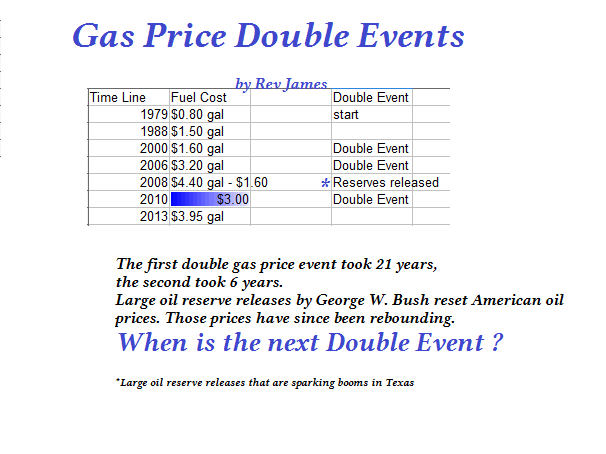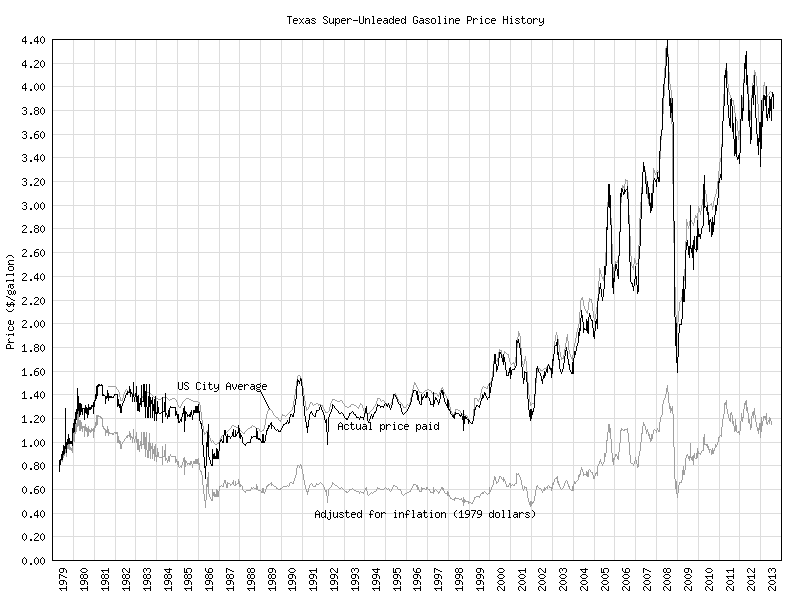How To Predict Gas Prices
JJJ Publishing™
-Rev James Jones
Flow charts are a simple and reliable method of tracking anything. They work on simple formulas that have proven true in science, industry and agriculture for several generations now. Our economy and big business have became dependent on them. If you know how to use them properly you can easily predict gas and food prices in the U.S. yourself. This knowledge can help you prepare for the future and tell you where you should invest your resources. If you feel you don’t have any resources then maybe this will help you find ideas as to what you can do in the future.
Principals of a flow chart
- Timeline; a timeline from one point in time to another. Start with a point in time you desire and add several numerical columns, the time will fill in themselves as you progress.
- Fuel Cost; list fuel cost at each point in time.
- Predict future cost: every time the price doubled note from what point to what point. Example; $1.00 gal to $2.00 gal occurred from 1990 – 2000, it took 10 years. Then cut that time in half, 2005, and double the cost, $4.00 gal. When data gathered over longer periods of time is applied the accuracy of the chart increases.
Let’s give it a try.

Double Event
How many years did it take for gas prices to double? Divide that number by 2, cut it in half and add it to that prices date. At that date prices should double. Repeat the process, cut that amount of time in half and double the prices again. This is how a flow chart works. Efficiencies made in energy only increase consumption. Because of large oil reserve releases that occurred after the 2008 economic collapse, American oil price were temporarily reset and have steadily been returning. Even after the reserve release prices from 1988 to 2010 created a man made doubling event. Using this formula should give us a clear insight where gas prices should be going. The above chart is from 1979 to 2013. The charts and sources I got these statistics from is listed below.

Link from Energy Trader Insider

Doubling events are mathematically correct for all growth, including humans. If you remember something called Farm Aid then you have already seen the beginning of fuel cost in an inefficient society, The same fate already has begin to fall on independent truckers in the United States. As gas price rose I watched independent owners I knew loose their rigs and return to the labor force. Growing up in central Texas I went from $12.00 an hour labor jobs in the oil field in 1980 to skilled jobs for $3.25 an hour by 1988. I supported a family the best I could through these times. times I thought would be better than my dads, from 1940 – 1980. They weren’t, thats why I’m doing this. If you can help add to this time line please do so.
This Post is based on the assumption that Peak oil is an actual occurrence based on these articles.
“Collapse is the story of Michael Ruppert, former Los Angeles police officer turned rogue reporter whose eerie prediction of the current financial crisis shocked millions. Now Ruppert is warning of a new meltdown, one rooted in oil, economics, and covert U.S. policies that are leading us all towards unprecedented global disaster. Is he a prophet who can clearly see Americas’ terrifying future, or a conspiracy theorist fueled by fear and paranoia?” That’s something I don’t know. What I am aware of however, is that it is a possibility that we should all be prepared for. You can watch the documentary below, if you like. It’s quite good.
“Collapse” in mind, I have put together a list of potential jobs to look into for the future, in worst case scenarios. These are the most basic of professions, things that we have been doing since the beginning of civilization and will most likely continue being viable professions.
- Midwives
- Barber
- Medicine
- Textile
- Food
- Protection
The oldest known forms of income, in order. From apparent records of human history the 6 trades listed above have existed since the civilizations of men.
Midwives: Midwives did more than help with the birth, they surely had been a member of the community the women the assisted lived and had probably known then their entire lives.
Prostitutes: We are programmed to propagate, it’s how a species survives. Unfortunately men need to propagate more than women, hence the reason women create 400+ eggs in their life and a man creates billions of sperm. This makes sex the easiest thing to sell. (Just make sure you’ve still got condoms. Lambskin, folks!)
Barbers & Doctors: It’s no wonder why barbers would become the first doctors. They were so familiar with each person they saw. Every mole, each new hair they saw. They shaved, groomed and prepared each person for a possible encounter for mating.
Textiles, Potters & Carpenters: People have always needed for clothing, blankets, rugs, pottery, building. Textiles are something humans have done for tens of thousands of years. A reliance that still exists today, except in many instances the producers are far away and you don’t know their names or their working conditions. This is something we could lose. I don’t know anyone that can weave a sheet.
Food: Clearly a vital profession, we will need people to raise and grow livestock and vegetable material in our communities. Say good bye to oranges in winter! It takes up to 4 acres of land to grow enough food for one family. It would be best to have a community farm as opposed to individual ones.
Protection: And of course, a warrior force. You will always need to protect yourself from those around you. We will need trained fighters.
Of course, it isn’t the end of the world. It’ll just be a lot different from this.
